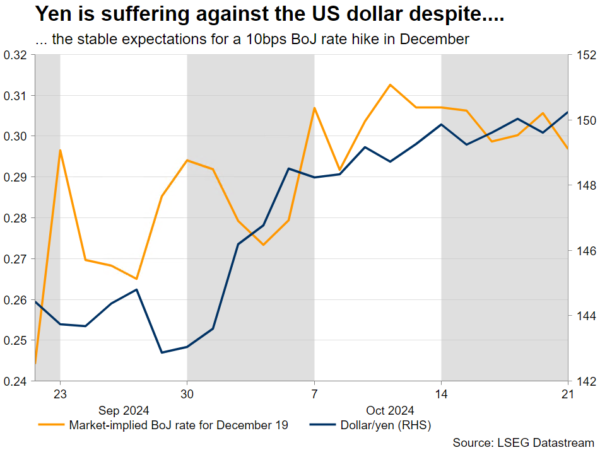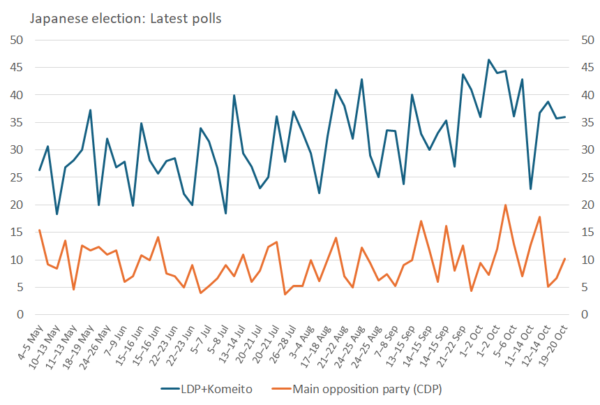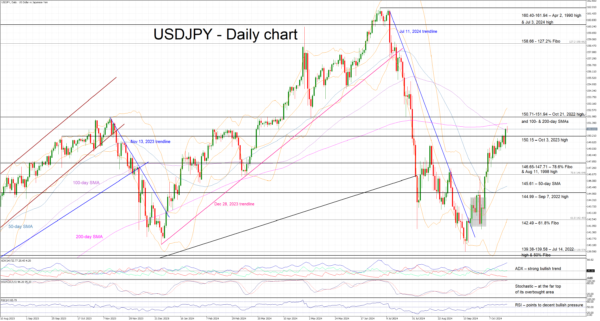- Japanese snap election will be held on Saturday, October 27
- Governing LDP party vying for another win but outcome uncertain
- BoJ’s outlook could be clouded if LPD doesn’t achieve majority
- Yen could suffer if the new government focuses more on fiscal policy
Japan holds elections on October 27
Just a few days before the key US presidential election and the much-discussed November 7 Fed meeting, Japan will hold a general election. This is a key moment for the country and especially the Bank of Japan, which after almost 18 years managed to hike interest rates and appears willing to continue tightening its monetary policy stance.
Why was snap election called?
The former Prime Minister (PM) Kishiba was forced to resign in August on the back of a number of scandals. Ishiba won the internal Liberal Democratic Party (LDP) contest and upon becoming the new PM, he announced snap election for October 27, one year before the scheduled date, despite holding a strong majority in the lower house.
The profile of the next PM
Ishiba rose to the top LDP spot after a handful of unsuccessful attempts, most notably losing to former PM Abe in 2012 by a handful of votes. Ishiba has always been very vocal about defence and foreign affairs, talking about an Asian NATO and strengthening Japan’s military to counter China’s aggression.
He is not overly fond of fiscal consolidation despite Japan’s debt-to-GDP rising north of 250%. Ishiba has a clear preference for stimulus packages and has announced a support package to help rural areas cope with rising costs. Interestingly, Ishiba has talked about revising the current flat, non-progressive tax structure in Japan. He looks more determined to implement changes compared to his predecessor, but his strategy will be ultimately defined by the election results and the strength of the economy.
Ishiba’s view about the BoJ
Upon news of Ishiba’s win in the LDP run-off, the market cheered with the yen gaining and stocks falling as he was seen as clearly more pro-hawkish than his main competitor, Takaischi. However, since taking over and during the pre-election campaigning, Ishiba and the new economic minister have changed the tune.
Comments like “we are not in an environment for additional rate hikes” and “the BoJ should be careful about raising rates given it takes time to completely exit deflation” are prime examples of the new LDP leadership back peddling on its original stance. BoJ’s independence is not questioned, but, as history has shown, only the combination of fiscal and monetary policies could produce results in Japan.
The market is still pricing in a 70% chance for a 10bps rate hike on December 19, but such a move clearly depends on the October 27 outcome and on external factors like the US presidential election, the Fed decisions and the developments in the Middle East. At least, the BoJ hawks might still be able to smile as there are reports that the largest union Rengo is aiming for a more than 5% wage hike for next year’s spring wage negotiations.
Majority is not guaranteed according to the latest polls
Following the declaration of the snap election, most polls had the LPD easily winning the 233 seats needed for a majority and forming another government with its junior partner, the Komeito party. However, the most recent polls have opened the door to the possibility of the LDP performing quite badly on October 27 and potentially falling short of achieving an outright majority.
Main scenarios for the election
(1) Easy win by LDP and a new government with Komeito – 60% probability
Despite almost 40% of the voters being still undecided and the numerous LDP scandals, the opposition remains fragmented and hence the Japanese public will most likely give LDP another chance.
A strong win would allow Ishiba to implement his strategy about brave fiscal expansion, possibly at the expense of a tighter monetary policy stance. The BoJ would remain open to further rate hikes, but the lack of coordination could diminish the current dynamics. The yen could suffer from the removal of the biggest tailwind with dollar/yen underperforming and rising again below the 152 area.
(2) Weak result by LDP and its allies but still achieve the necessary majority – 30%
This scenario is gaining traction according to the latest polls. In this outcome, the new PM Ishiba might be forced to seek more coordination with the BoJ. He has finally managed to become the PM, and he will do everything to remain in charge.
Understandably, Ishiba will still pursue his fiscal expansion plans with questionable funding sources as tax increases will hit consumption again. But the chance of a December BoJ rate hike will remain alive with the yen possibly reversing some of its recent underperformance.
3/ No majority achieved, search for further coalition partners follows or new election – 10%
This is probably the worst scenario for the BoJ as the political unrest could force Ueda et al to postpone any rate decision unless the mist clears. Negotiations for a grand coalition would follow and potentially result in an agreement, especially as minority governments are extremely rare in Japan.
In this case, the yen will remain under pressure with dollar/yen continuing its journey north. This rally could really pick up speed if the incoming US data prints remain on the strong side.


















